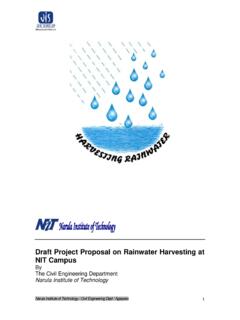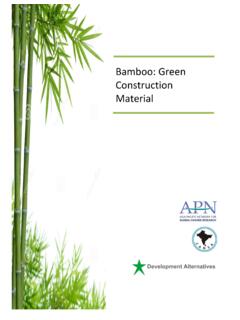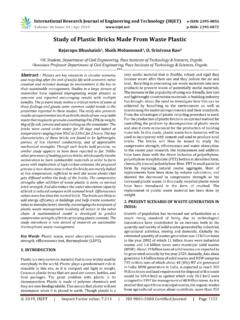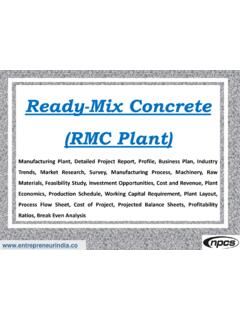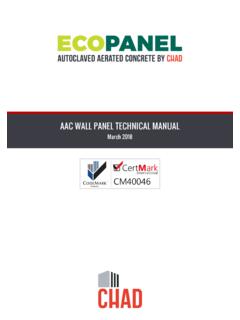Transcription of Japan’s Resource Circulation Policy for Plastics
1 Japan s Resource Circulation Policy for PlasticsYusuke INOUED eputy Director, Recycling Promotion DivisionEnvironmental Regeneration & Resource Circulation BureauMinistry of the Environment, JapanMarch, 2018 Plastic Waste(9,400kilotons)Used Products(8,680kt 92%)Production Loss(720kt, 8%)Packaging Law(municipal collection)1,040ktHome Appliance Law120ktSmall appliance Law6ktConstruction LawAutomobile Law220kt ASR Other(Outside of recycle burnable waste 6,880ktRecycling2,330kt(25%)Energy Recovery5340kt(57%)Unutilized1,730kt(18% ) material Recycling2,030kt(22%)Chemical Recycling300kt(3%)PowerGeneration(3,190k t, 34%)Heat utilization(970kt, 10%)RPF/ cement raw fuel(1,180kt,13%)Incineration(980kt, 10%)Land-filling(740kt, 8%)(Year 2013)2 Small home appliance60ktAutomobile330ktConstruction 590ktPackaging, Container4,260ktPET bottle580ktPackaging3,680ktHome Appliance280ktAir conditioner, TV, Refrigerator, Washing machineOther product3,060ktHousehold goods, Clothing,Furniture, Toy,Agri-Fishery tooletc[Use & waste generation][Collection]Packaging745ktPET bottle292kt Plastic waste = tons/year ( of total waste: 431mt Recycling rate = , Recycling & Recovery rate = CO2 emission (mainly incineration): 18 million tons (60% of waste sector)[Recycling/treatment] material Flow of Plastics in Japan[Case study] 9 industries (incl.)))
2 Supermarket, laundry services, drug store, DIY store) charge plastic bags 95 of consumers bring MY Bags previously just 10-20% [Toyama Prefecture, Mar 2016] GovernmentPR CoordintateBusinessesStop free bagsCitizensEnhance actionsTripartite Agreement for reduction of plastic bags Reducing plastic bags by partnership -agreement, voluntary actions Charge of plastic bags major for supermarket and CO-OPChargeof plastic bagsSupermarket80%CO-OP62%Drug Store25%Department Store20%ConvenienceStore9%0,0010,0020,00 30,0040,0050,0060,00H14/ 9 2 7 12 5 10 3 8 H18/1 6 11 4 9 2 7 12 5 10 3 8 H23/1 6 11 4 9 2 7 Refusal rate of plastic bags at sueprtmartSep (Japan Chain Store Association ( 5 cent for a big bag3 cent for a small bag)3 Reduction of Plastics40100200300400500600700 MunicipalitiesNumber of waste separationSeparation & Collection of Municipal waste 2015 Municipal waste: mainly 10-20 Separation for collection, recycling Plastic: Separation into 4 (Packaging, PET bottle, PS tray, Goods)Municipal waste Plastic packaging 745kilotons/year PET bottle 292 kilotons/year PS tray 6 kilotons/year Plastic goods (*collected by small number of municipalities) Plastic wasteCollection of municipal plastic waste by municipality5 Separation into 4 (Bottle, cap, PS tray, Egg pack) with collection boxPET bottle 20kilotons/yearEgg pack(Station)CapPS tray 10kilotons/year(Shopping Mall)Collection of Plastic waste by business6 Bottle collection connected with Electric Money systemIncentivized Collection of PET bottlesStoresLogisticsRecyclersMechanica lRecycling(Bottle-to-Bottle)Recycled bottlesBeverage ManufacturesCollection and Press of used bottlesResourceCirculation7 Output: 60% as chemical recycling.
3 40% as material recyclingMaterial (Mechanical)RecyclingChemical (Feedstock)RecyclingOtherPaletteSyngasBl ast furnace reducing agentsCoal alternative with cokes ovenRecycled resin( )PP resin (pellet)= $300-400/ton(The Japan Containers and Packaging Recycling Association Recycling of plastic packaging Fiber34%Sheet44%Bottle21%Moded item1%8 Output: 100% as material recycling (Sheet, Fiber, Bottle etc) (FY 2017)(PET bottle with 100% recycled resin)(Recycled PET tray for food)(The Japan Containers and Packaging Recycling Association Recycling of PET bottles9 Collection & Recycling of Plastic Products with PackagingPP etcPerspectiveResultSummaryQuantity +36% : (packagingonly) / Noproblem with all recycling& recovery; same/better quality of recycled resins (compared to packaging only)Efficiency Reducedthe cost of overlapping sorting processes(between municipality and recycler)Civilians acceptance(byenqu te: n=1416) 74% regardas easier separationthan packaging only;81% say this separation system should be adoptedCombination of Mechanical, Chemical(feedstock)recycling & Thermal Recovery Model Projects in 7 cities (approx.)))
4 82600 people in total) in FY2017[Cites of Yokohama, Kawasaki, Osaka, Nagoya, Toyama, Hiroshima, Kitakyushu] New Financial scheme corresponding to China s National Sword. Promotion of domestic Resource circulationSeparated CollectionMixed CollectionSophisticated SortingSimple SortingWashingCrush/PressExport of Plastics .5 million tons/yearPET exportedto ChinaExport of HousholdPlastic Waste to ChinaMaterializationBeforeFrom January 2018[Example][Example] Financial support for upgrading domestic recycling (Subsidy for new facilities) No limit subjects (waste emitters, sorters, recyclers, compounders, molders OK) Budget: $4million in FY2017 $15million in FY2018 MOEJD omestic Circulation1011 Strong incentives for 3Rs of Plastics Actions for reduction Use reusable goods & recycled materials Mandatoryfor the national government Obligatory to make effortfor local governmentsLaw Concerning the Promotion of Procurement of Eco- friendly Goods and [Retail businesses]charge of plastic bags / reduction of packaging waste2euse [Cafeteria]use reusable [Stationery]>40% as recycled plastic.
5 >20% as post-consumer plastic [Office Furniture]>10% as recycled plastic or >25% as bio-plastic [Computers]>40% as recycled plastic [Uniforms, Interior Fixtures]>25% as recycled/bio plastic ( reusable cup)Public Procurement12 Further challenges for Resource Circulation Huge potentials on 1) reduction 2) quantity 3) efficiency 4) MarketReduction of environmentally harmful Plastics Minimize use of plastic bags/packaging Collection & recycling of unutilized Plastics (* million tons) Collect -plastic goods & other recyclable Plastics Optimize -combination of recycling & recovery Efficient 3Rs system Integrate citizens separation & industrial sorting Exceed -vertically segmented recycling laws(*packaging, automobile, home appliance, small home appliance)Activation of Recycled/Bio plastic market Incentives -goods made of recycled/bio Plastics ( Discount on recycling fee for recycled/bio resin-used car) 13 30 2 15 Under proposal: in the draft of New Plan for a Sound material -Cycle Society To be covered: Reduction, Reuse and Recycling of Plastics ; Utilize Recycled Plastics & Bio- Plastics Resource Circulation Strategy for Plastics Correspondingtovariouschallengesincludin gResource&Wasterestriction,MarineLitter, ClimateChange EstablishingaSustainableSociety&handingo verRichEnvironmenttotheNextGeneration Reducingthedependenceonnon-renewablereso urces&shiftingtorenewableresources Collectingusedresourcesthoroughly&re-uti lizing(reusingandrecycling)themmanytimes withconsiderationoneconomicandtechnologi calfeasibilityBasic PrincipleReduction in the use of Plastics contributing to lower environmental impacts, such as the reduction of single-use packaging and productsCollection and Recycling of used plastic resources like un-utilized Plastics in the radical, effective and efficient mannersImprovement in the Practicality of Bio- Plastics and.
6 Replacement fossil-fuel based Plastics with Bio-PlasticsConcrete Measures123 Thank you so much for your attention Please feel free to contact me 3 5501 3153 Mottainai( ) Japanese cultural word: a sense of worthiness and regret wastefulness Exclamation when something useful is wasted - Don t waste anything worthy Kenyan environmentalistWangariMaathai used Mottainaias a slogan for the four Rs:reduce, reuse, recycle and repair. We should all use limited resources effectively and share them fairly if we are to avert wars arising from disputes over natural resources. 1415511350905127518052225291531053615370 5483546854205427533852725202508248114625 4536163815301496141413601309120111351087 1051995903845809733681635553507484010002 0003000400050006000199119921993199419951 9961997199819992000200120022003200420052 0062007200820092010 The generation of municipal wastecontinues to decreaseafter recording a peak of million tons in 2010. The amount of final disposal tends to decrease along with progress in recycling and reduction of waste waste final disposalMunicipal waste generationFinal disposal (10,000 tons)Waste generation (10,000 tons)*Waste generation per day per head (g/person day)-19911,118(g/person day)-20001,185 (g/person day)-2010976(g/person day)**Changes in municipal waste generation and final disposal AppendixThe total generation of industrial waste has remained 390 million tons in 2010, almost unchanged since 1990.
7 The final disposal tends to decrease with progress in recycling and a declining tendency of industrial waste in recent 398 403 397 405 394 405 415 408 400 406 400 393 412 417 422 418 419 404 390 386 8991898480696867585045424030262422201714 1402040608010012014016018020005010015020 0250300350400450500H2H3H4H5H6H7H8H9H10H1 1H12H13H14H15H16H17H18H19H20H21H22 t t Generation (million tons)Final disposal (million tons)Final disposal (mil. tons)Generation (mil. tons)Changes in industrial waste generation and final disposal 1990199119921993199419951996199719981999 2000200120022003200420052006200720082009 2010 AppendixPeriodContentsEnactment of lawsPost war -1950s-Waste treatment as a measure for environment and health protection-Conservation of healthy and comfortable living environment-Public Cleansing Act (1954)1960s -1970s-Amount of industrial waste increases along with the high economic growth and the problem of pollution comes to the treatment as a measures for environment conservation1980s-Improvement of waste treatment plants is promoted-Environment conservation along with the waste treatment1990s-Waste disposal control and promotion of recycling-Establish various recycling systems-Countermeasures for hazardous substances (incl.)
8 Dioxin)-Introduction of systems for proper waste treatment, to accommodate a large variety of kinds and characteristics of waste2000 --3R Promotion for building of a sound material -cycle society-Reinforcement of measures of industrial waste treatment-Control enhancement of illegal waste disposals17 Resources/sound material -cycle societyPollution / environmentHealthHistory of regulations related to waste management and recycling-Act on urgent measures for improvement of living environment (1963)-Waste Disposal and Public Cleansing Act (1970)-Amendment of the Waste Disposal and Public Cleansing Act (1976)-Act on Bay Area Marine and Environment Consolidation Centers (1981)-Law for Combine Household Wastewater Treatment Facility (1983)-Amendment of the Waste Disposal and Public Cleansing Act (1991)-Act on Promotion of Development of Specified Facilities for the Disposal of Industrial Waste (1992)-Basic Environmental Act (1993)-Act for Promotion of Sorted Collection and Recycling of Containers and Packaging (1995)-Amendment of the Waste Disposal and Public Cleansing Act (1997)-Home Appliance RecyclingAct (1998)-Acton Special Measures against Dioxins (1999)-Basic Act on Establishing a Sound material -Cycle Society (2000)-Law for thePromotion of the construction material recycling and Utilizationof Recyclable Food Resources (2000)-Amendment of the Waste Disposal and Public Cleansing Act (2000)-Act Concerning Special Measures Against PCB Waste (2001)-End-of-Life Vehicle Recycling Law (2002)-Act on Special Measures concerning Removal of Environmental Problems Caused by Industrial Wastes (2003)-Amendment of the Waste Disposal and Public Cleansing Act (2003 -2006, 2010)-SmallElectrical and Electronic Equipment RecyclingAct (2013)
9 AppendixWaste Disposal and Public Cleansing ActAct on the Promotion of Effective Utilization of ResourcesAct for Promotion of Sorted Collection and Recycling of Containers and PackagingBasic Environmental ActBasic environmental plan Promotion of material recycling Proper disposal of waste Regulations depend upon characteristics of articles and materialsBottles, PET bottles, paper/ plastic containers Air conditioner, refrigerator, freezer, TV sets, Washing machine, clothes dryerActon Promoting Green Purchasing (Promoted by the government taking initiative for purchasing of recycled products)Wooden/concrete/ asphalt materialsFood residueAutomobile Home Appliance RecyclingActConstruction Waste Recycling LawEnd-of-Life Vehicle Recycling Law -Maintain proper material cycle of the society-Reduce the consumption of natural resources-Reduce environmental loadBasic Act for Establishing a Sound material -Cycle Society(Basic framework law)18 Control waste generation Proper treatment of waste ( ) Regulation on establishment of waste treatment plants Control for waste treatment service companies Setting of criteria for waste disposal, etc.
10 Recycling of recyclable resources Design and review the structure and materials for facilitating the recycling Indicate how to separate waste Promote the effective use of secondary productsReduceRecycle ReuseRecycle(1R) (3R)Fundamental plan for Establishing a Sound material -Cycle Society( =Fundamentals of other national plans)Put completely into effect in August 1994 Revised completely and published in April 2012*Full enforcement: January 2001*Published in March 2003, Completely revised in May 2013*Partially amended in May 2010 *Revised completely and published in April 2001 Fully enforced in May 2001 Partially amended in June 2007 Fully enforced in April 2001 Fully enforced in April 2000 Partially amended in June 2006 Fully enforced in May 2002 Fully enforced in January 2005*Fully enforced in April 2001 Food Recycling LawSmallElectrical and Electronic Equipment RecyclingAct Small electrical and electronic equipment Enforced in April 2013 Legal system for building a sound material -cycle societyAppendixThe recycling rate of municipal waste is (FY2010).











